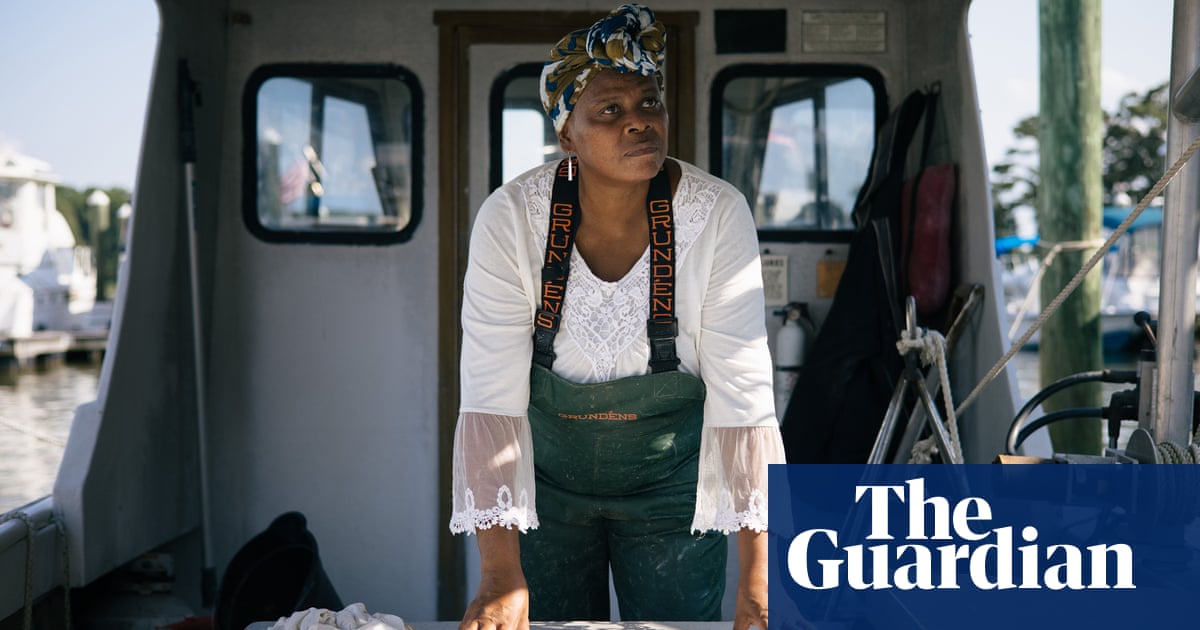After slavery, oystering offered a lifeline. Now sewage spills threaten to end it all
On a cold winter morning early this year, Mary Hill was helping her 101-year-old mother get ready for the day when she received a distressing email alert. Tens of millions of gallons of raw sewage were heading for her prized family oyster beds.
Yet Hill was not surprised that the wastewater pipe built in the 1940s had succumbed to corrosion. “Here we go again,” she thought grimly.
This is our land, we were founded by freed slaves, that’s who created this community.
Hill is one of the last remaining Black oyster-people in this part of the US east coast, and is part of a tradition that stretches back generations, to the end of slavery. Yet spill after spill of sewage is threatening to end Hill’s livelihood and her historic occupation, and are part of a broader problem in nearby communities: Black people are disproportionately suffering under the weight of a sewage crisis.
For four months, Hill was unable to harvest her oysters because of the leak. “It is devastating,” Hill said. “It seems like a form of systemic racism not just for me as an African American female, but for those who are not the 1%.”
Oysters grow in the waterway that the Virginia health department shut down in January 2021 after a wastewater line break spilled sewage into the James River. Photograph: Alyssa Schukar/The Guardian
Alongside the leaks into the river, there are sewage problems in homes in historically Black communities in this part of coastal Virginia, where some residents cannot flush their toilets and face an overflow of green, sludge-like algae. It is a symptom of decades of neglect by the cities’ governments.
Majority white neighborhoods in the area are supplied by city-run sewer systems that take wastewater away from their homes. Many houses in majority Black villages, some founded by freed slaves, rely on individual septic tanks because the city sewer lines don’t extend to their homes. These tanks often have sewage backups, and if not routinely maintained can contaminate the water both above and below ground. The sewage discharge problems grow far worse when the area floods, which is becoming more frequent as sea level rises.
Show more
In the sprawling waterways of Virginia, formerly enslaved people like Hill’s great-great-grandparents carved out economic independence, working for themselves when the civil war ended. By 1870, more than a dozen African American oystermen cultivated a livelihood for their families, working the water on the James River peninsulas. Hobson, the beloved village where Hill grew up, is one of the few historic Black oyster communities in the nation.
“We found our livelihood in oystering,” Hill said while sitting on the porch of the house she grew up in. Behind the one-story wooden house, generations of Hills dating back to 1700s are buried in the family cemetery. “What was such a blessing about this industry – I felt that we were wealthy,” Hill said. She recalled her father working the boat, rain or shine, and her mother baking the oysters that he brought home.
In the early part of the 20th century, the oyster industry was the largest source of employment for African Americans in the county. But by the 1990s, the industry dwindled as the population continued to decline. Hill is in business today because of her predecessors’ foresight – and their decision not to sell their oyster beds.
Hill inherited 2,000 acres of family oyster grounds on the James river and its tributaries. She tends to them, cares for her mother, and also established wholesale dealership Barrett’s Neck Seafood two years ago. Despite the financial pressure of starting a business, and the cost of fixing the two boats she owns, she means to tend to her oysters for as long as she is able to.
But the spills have put all her labors on an indefinite pause.
A painting of Black oystermen, including two relatives of Mary Hill, is on prominent display in her childhood home. Photograph: Alyssa Schukar/The Guardian
On 4 January, 29m gallons of untreated sewage water flowed into the James river. The four-day spill was caused by corrosion in a Hampton Roads Sanitation District (HRSD) pipe. The discharge prompted the Virginia department of health to enact an emergency shellfish harvesting closure across 18,630 acres that stayed in effect until mid-March, with some areas condemned until mid-April and June. The shutdown affected roughly 200 people who regularly harvest shellfish in the area. Hill had anticipated selling the shellfish for $50 a bushel to local restaurants and markets. Instead she lost out on winter, spring and summer harvests altogether.
In April, when most of the affected leases reopened, Hill was hopeful. She went on the water with her crew, but her boat’s motor malfunctioned and they had to return to the shore without the harvest. By the time she got it fixed, the state health department issued another closure order due to overland runoff from heavy rainfall. A dozen golf clubs and riverfront hotels stand on the edges of the Nansemond River, a tributary of the James River.
A dock that gives access to the Chuckatuck Creek and James River. Photograph: Alyssa Schukar/The Guardian
“Closure after closure after closure – ever since the spill,” Hill said, exasperated. “And all these huge properties with their manicured lawns are causing the runoff of fertilizer into the river.” Recently her own drinking water has tested positive for coliform bacteria, a sign that it could be contaminated.
More troubling, the January spill was not an isolated case. Just four months earlier, 2.5m gallons of wastewater were spilled when a pump failed. In October 2019, about 106,200 gallons of sewage leaked into a retention pond in the city of Chesapeake. In May 2018 there was a sewage leak in the nearby city of Hampton.
Show more
“HRSD experiences spills multiple times each year, just as all wastewater systems do,” said Leila Rice, HRSD spokesperson, in an email to the Guardian. “There are mechanical failures, pipe failures, damage by third parties, and capacity-related overflows. HRSD is investing heavily in system improvements to minimize spills – but they are inevitable.”
Those affected have found an unsympathetic audience. Last December, the Virginia state supreme court heard a case made by an oysterman who argued that the city of Suffolk and the Hampton Roads sanitation district do not have the right to pollute the Nansemond River. The court decided against the oysterman. A justice wrote that existing laws and statutes do not grant oystermen the “right to grow oysters in conditions free of pollution”.
The reality that Hill is one of the last remaining Black oyster-people in the region is not lost on her. The pressure she faces as she attempts to hold on to the craft and livelihood she inherited is palpable. As she drove to check on one of her boats, a member of a well-known family of watermen left a voicemail, asking if she was looking to sell her oyster grounds. A few years ago this same person, Hill said, told her that there were no oysters in the grounds she owned – the very grounds he now wanted to buy.
The January river spill brought to the surface the dangerous impact of the region’s aging sanitation system. But while the wastewater in the James River is affecting people’s livelihoods, the backed-up sewage in people’s homes is affecting their day to day lives.
Drainage runs across properties throughout the historic African American Pughsville neighborhood.
The area, which is near the Great Dismal Swamp, does not have modern drainage apparatuses and is known to flood. Photograph: Alyssa Schukar/The Guardian
The impacts are felt unequally. The population of the city of Suffolk, Virginia, is 42% Black, and neighboring Chesapeake is 30% Black, both more than twice the national average. This reflects a broader trend. A 2019 report by the US Water Alliance found that “vulnerable communities disproportionately lack access to water and sanitation, in part due to discriminatory practices embedded in some past water infrastructure development initiatives”.
“Have you heard the song ‘Wish it would rain?’” Roosevelt Jones asked, sitting in the leather armchair of his living room alongside his wife, Catherine. “We hope it don’t rain.”
Roosevelt and Catherine Jones walk through their backyard, which floods whenever heavy rain falls in the town where the couple has lived their entire lives. On the left side of the frame is a ditch dug out to drain water away from their home. Photograph: Alyssa Schukar/The Guardian
On a recent visit, their home, full of framed photographs of their daughters and grandchildren, was a testament to the 63 years they’d spent together since they met on the bus to their high school. Even at 77, Catherine said, she was the owner of a catering business and an active member of the civic league along with her husband.
When the Joneses use the bathroom, they are unable to flush, wary of the water coming back up in the bathtub, toilet or the kitchen sink. They can’t take a shower, so they resort to storing water and using them for bowl baths. “When I get to the city council meeting the next time I’ll tell them: ‘You want to go live in my house for a week, when it rains, and I will live at your house?’” Catherine said.
Catherine Jones prepares a Father’s Day cake to share with family in her backyard, which floods whenever heavy rain falls. Photograph: Alyssa Schukar/The Guardian
Snaking across their front lawn are ditches that the Joneses have dug to funnel rainwater and sewage effluent away from their property. When it floods, the groundwater level can rise and fill the septic tank, causing wastewater to back up in their house and to leak out into the ditches. More than 90% of Suffolk is not suitable for septic systems because the soil is too sandy, according to a US agriculture department survey.
These ditches are prevalent in Suffolk, distinguishing which houses are susceptible to flooding and which stand on higher ground.
The city of Suffolk gets roughly 116 days of rain a year, with an average of 48in, 10in more than the national average. Stormwater flows in open ditches and is released into larger above-ground culverts and retention ponds that make up the city’s drainage system. On its way the stormwater can pick up septic tank runoff, fertilizer, sediment, pet waste, silt and other pollutants that can contaminate waterways and damage coastal habitats. For the past 15 years, residents of Suffolk and Chesapeake have paid stormwater fees intended to take care of just such drainage and surface runoff – even though the problems continue.
Residents in Suffolk, Virginia, say that construction of new homes have caused increased flooding after rainfall and sewage backup in their bathtubs and toilets. Photograph: Alyssa Schukar/The Guardian
To make matters worse, greater Suffolk’s stormwater runoff feeds down into culvert networks in Pughsville, a historic African American village on the city’s border with Chesapeake that has overwhelming drainage problems of its own.
“The Suffolk side is allowing builders to install septic tanks on people’s property. And when that backs up, it goes into people’s homes, and that’s not just in Pughsville,” said Pamela Brandy, who represents the Pughsville Civic League.
Across the village, four large culverts often get backed up, overflow and flood whenever heavy rain falls. Due to Pughsville’s lower elevation, it receives stormwater runoff from both Suffolk and Chesapeake.
“None of the four culverts have been cleaned out since they were put in there in 2016,” Brandy said. “There’s poop and all of this green stuff in the water that has never been there before.” Brandy takes photos and documents the frequent drainage and overflow problems.
“The culverts are maintained and cleaned as needed due to blockages from debris flowing into them from upstream private property,” said Tim Kelley, a spokesperson for the city of Suffolk, in an email to the Guardian. “They are also normally checked at least annually and prior to any anticipated major storm events.”
Ralph Northam, Virginia’s governor, announced earlier this month that the state plans to allocate $411.5m from the federal government’s Covid stimulus package to reduce water pollution and increase access to clean water across the Commonwealth. But how the proposed relief will be distributed in this region of the James River is not clear yet.
Braxton Miller, 5, swings near a culvert that connects the Pughsville neighborhood to the larger drainage system. Photograph: Alyssa Schukar/The Guardian
“I just want to find out – what is the plan to get the water out of Pughsville?” Brandy said. She speaks up in town halls and city council meetings on behalf of her community, but she said there has been little to no action from the city government.
“This is our land, we were founded by freed slaves, that’s who created this community,” Brandy said. In the 1800s, the Great Dismal Swamp that covers parts of Suffolk and Chesapeake was a known route for escaped slaves as they traveled north via the Underground Railroad. “If you keep buying up and building like this, then there will no longer be a Black historical neighborhood.”
Wayne White, president of the Pughsville-Suffolk Civic League, looks at a new building in his historic African American community. Photograph: Alyssa Schukar/The Guardian
Locals are wary of a surge of new development that began in 2018, the majority of which is intended for military veterans. There are fears it will overburden the fragile sanitation network, which was not designed for the amount of waste it already carries. Additionally, residents worry that construction is taking place on land that is susceptible to stormwater flooding and lacks proper drainage. Sea-level rise will make matters worse. Nearly 600 houses in the area are categorized as most vulnerable to tidal flooding.
“We see these people building all these new homes on water,” Catherine Jones said, leaning on her cane. She gazes at three new housing developments being built on the edge of her backyard, and the two new two-story homes already standing. Before, it used to be all trees, trees that absorbed rainwater through their roots, trees that her kids, and then her grandkids would play in.
“I have a few more years on this earth,” Jones said. “I don’t want to leave my last few years dodging the rain.”
On 21 August, a month after speaking with the Guardian, she died at the age of 77.
The Guardian is partnering with Catherine Coleman Flowers, the award-winning sanitation researcher, to investigate sanitation shortfalls in the US. We’d like to hear from you if you face sanitation problems













